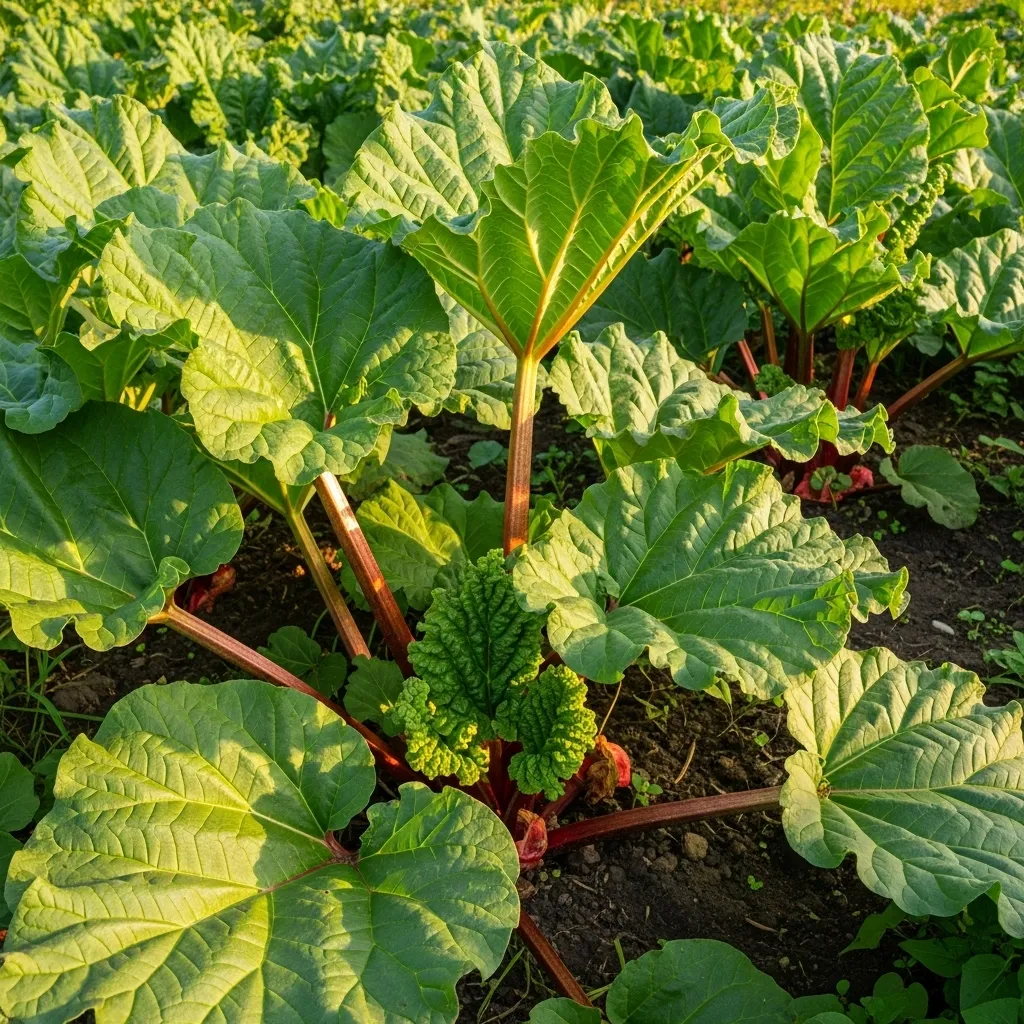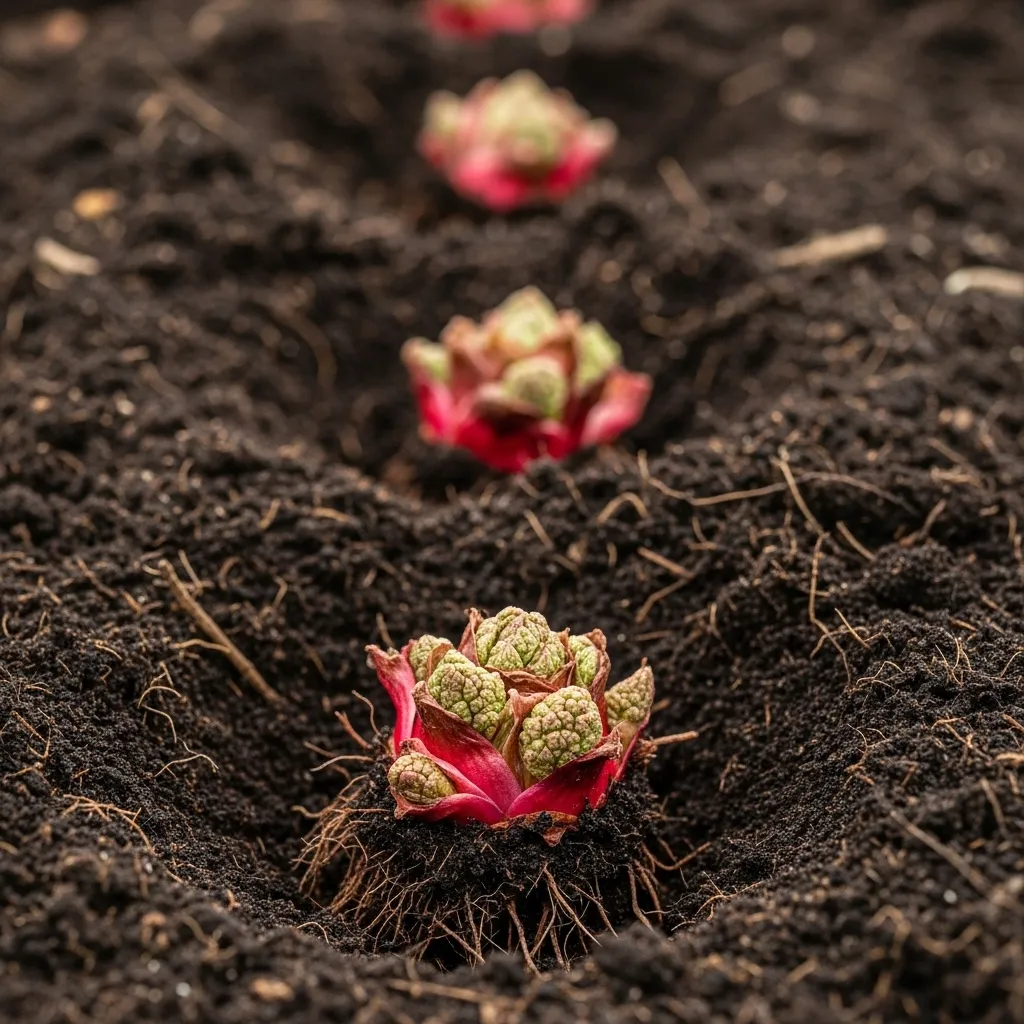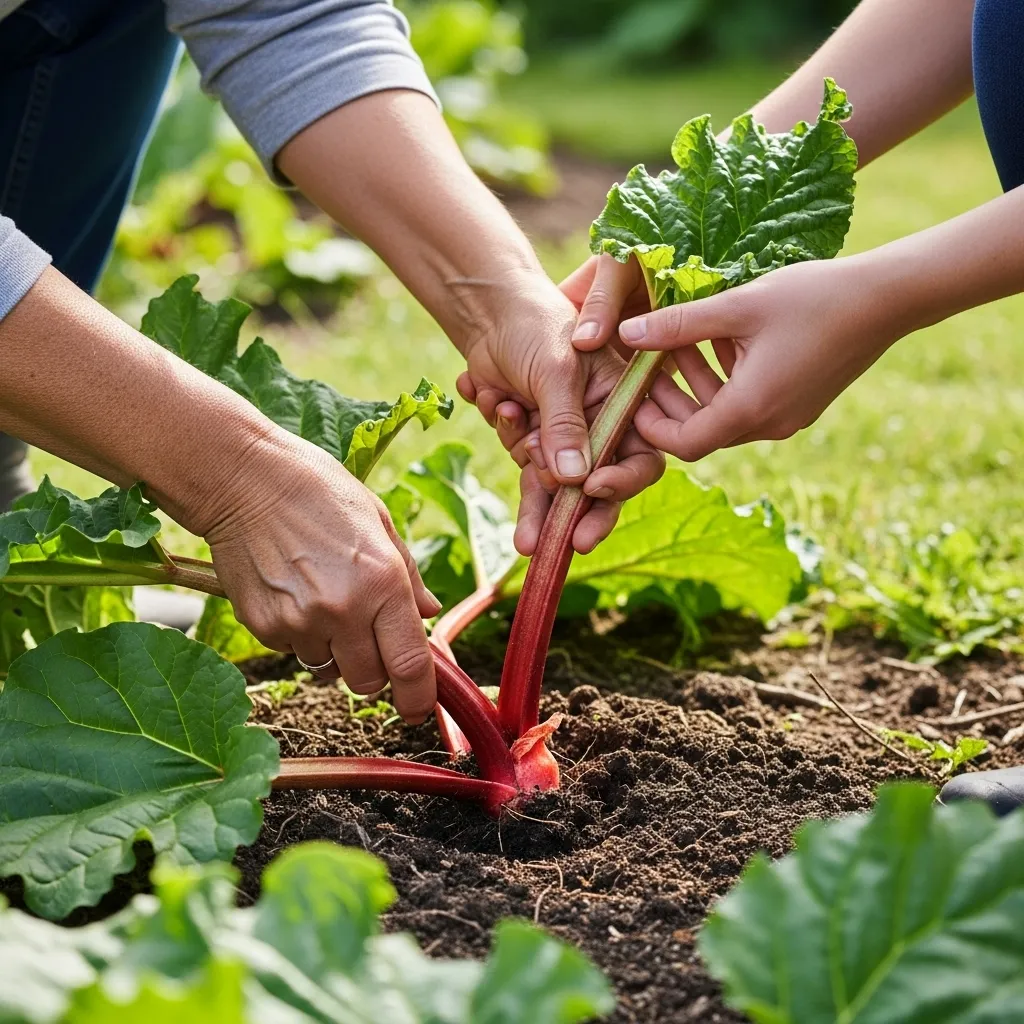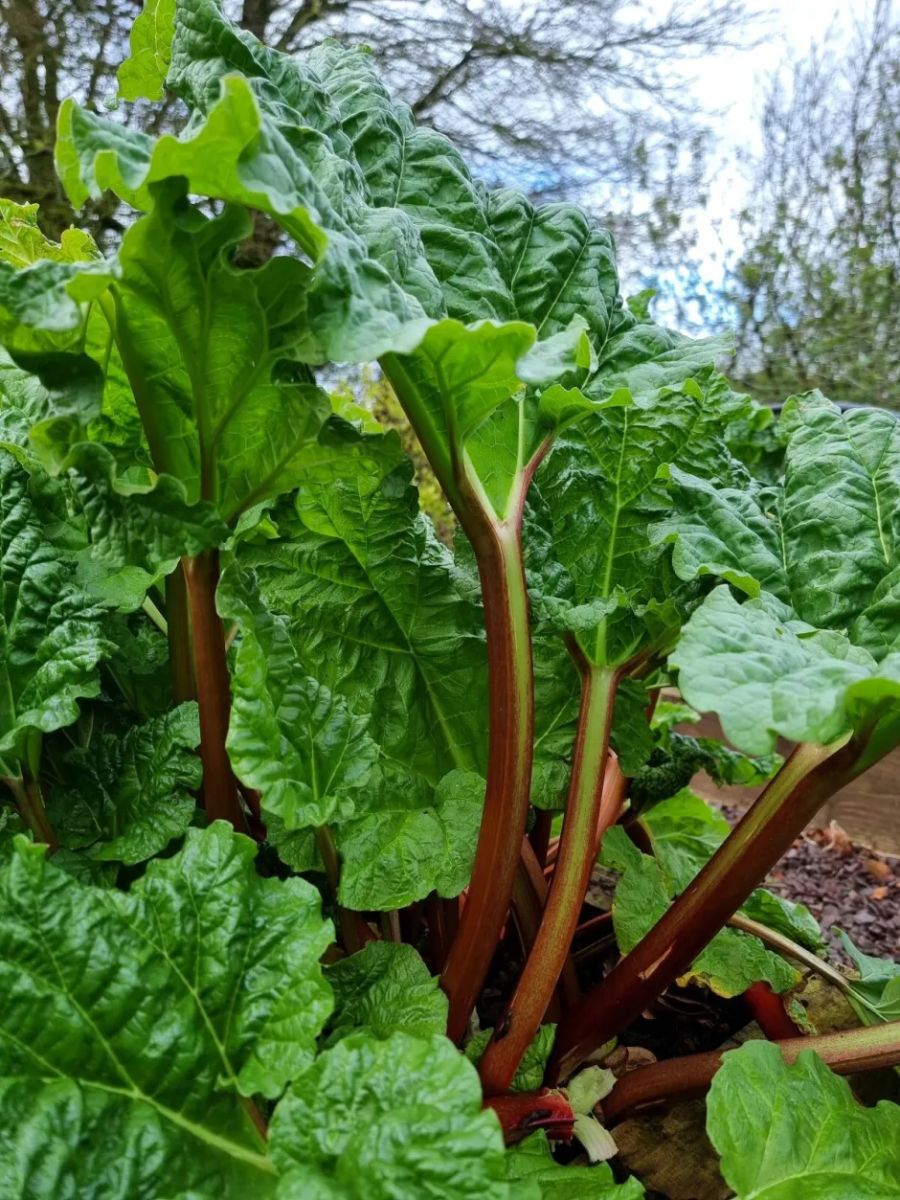Picture this: You plant something once, and it feeds your family for the next 20 years. Sounds too good to be true? Welcome to the world of rhubarb growing. This remarkable perennial vegetable has been quietly revolutionizing home gardens for centuries, and in 2025, it's experiencing a well-deserved renaissance among gardeners who want maximum results with minimal fuss.
I still remember my grandmother's rhubarb patch – a sprawling collection of enormous leaves that looked like something from a fairy tale. Every spring, those crimson stalks would emerge like magic, ready to become the star of countless pies, jams, and crumbles. What I didn't realize then was just how easy it was to grow this incredible plant.
Key Takeaways
- Plant once, harvest for decades – Rhubarb is a true perennial that can produce for 15-20 years or more
- Cold is your friend – Rhubarb actually needs winter temperatures below 40°F to thrive
- Choose the right variety – Red varieties look stunning but green varieties are often more productive
- Patience pays off – Wait until year two for your first real harvest, but it's worth the wait
- Less is more – Overwatering and over-fertilizing cause more problems than neglect
- Safety first – Rhubarb stalks are delicious, but the leaves are poisonous and must never be eaten

Table of Contents
- Is Rhubarb Right for Your Garden?
- Why Rhubarb Deserves a Spot in Your Garden
- Understanding Rhubarb Varieties: Red vs. Green
- The Perfect Rhubarb Growing Conditions
- Planting Your Rhubarb: A Step-by-Step Guide
- Caring for Your Rhubarb Plants
- Harvesting Your Rhubarb Bounty
- What to Do With Your Rhubarb Harvest
- Troubleshooting Common Rhubarb Problems
- Maximizing Your Rhubarb Harvest
- Ready to Start Your Rhubarb Journey?
⚠️ Safety Note: Rhubarb Leaves Are Poisonous
This is crucial information every rhubarb grower must know: While rhubarb stalks are completely safe and delicious to eat, the leaves contain high levels of oxalic acid and other compounds that are toxic to humans and pets. Never eat rhubarb leaves, and keep them away from children and animals. When you harvest, trim the leaves off immediately and dispose of them safely. The good news? You can add them to your compost pile where they'll break down safely. (Learn more about composting in How to Make Compost.)
Is Rhubarb Right for Your Garden?
Before we dive into the how-to details, let's make sure rhubarb is actually a good fit for your situation. This isn't a plant for everyone, and that's perfectly okay. Here are the key factors to consider:
Do you have cold winters? This is non-negotiable. Rhubarb absolutely must have temperatures below 40°F for several months to break dormancy and produce vigorous growth. If you live in a warm climate without cold winters, rhubarb won't thrive no matter how well you care for it.
Do you have permanent space? A mature rhubarb plant can spread 3-4 feet wide and live for 20+ years. This isn't a crop you can easily move around. You need a dedicated spot where it can grow undisturbed for decades.
Are you patient? You'll need to wait until the second or third year for a full harvest. If you're looking for quick results, rhubarb might not be your best choice.
Do you have limited space? You can grow rhubarb in a container, but it must be large – at least 20 inches wide and deep with excellent drainage. Container plants require more frequent watering and may be less productive than those grown in the ground. If container growing is your only option, choose compact varieties like 'Timperley Early.' For more tips on container gardening, check out How to Start a Container Garden.
If you answered yes to the first three questions, rhubarb could be perfect for your garden. Let's explore why this remarkable plant is worth the commitment.
Why Rhubarb Deserves a Spot in Your Garden
Let's be honest – rhubarb isn't the most glamorous vegetable. It doesn't have the Instagram appeal of rainbow carrots or the trendiness of kale. But here's what makes it absolutely brilliant: rhubarb requires winter temperatures below 40°F to break dormancy and stimulate spring growth, which means it's perfectly adapted to most temperate climates.
In my experience, rhubarb is the ultimate lazy gardener's dream. Once established, it practically takes care of itself. You don't need to replant every year, worry about succession planting, or fuss with delicate seedlings. Plant it once, and you're set for decades.
Want to know how much rhubarb you could harvest?
Try the Rhubarb Harvest Calculator to estimate your potential yield based on your number of plants, their age, and your growing conditions. It's a quick way to plan how many plants you'll need for your family's needs!
Understanding Rhubarb Varieties: Red vs. Green
Here's something that might surprise you: the color of rhubarb stalks has nothing to do with ripeness. Crimson Red is one of the most flavorful cultivars, featuring tall stalks and dependable yields, but green varieties often outperform their colorful cousins in terms of productivity and hardiness.
When I first started growing rhubarb, I was obsessed with getting the reddest stalks possible. I planted 'Canada Red' and 'Crimson Red' varieties, thinking they'd be superior. What I learned was that while red varieties are stunning, red varieties are typically smaller, less robust and more prone to diseases and problems than green varieties.
Best Red Varieties:
- Crimson Red – Excellent flavor, beautiful color retention after cooking
- Canada Red – Large stalks up to 20 inches, cold-hardy
- MacDonald – Wilt and root rot resistant, vigorous grower
Best Green Varieties:
- Victoria – The workhorse variety, incredibly productive and reliable
- Timperley Early – Ready to harvest as early as March
- Glaskin's Perpetual – Can be grown from seed, continuous harvest
"The key to successful rhubarb growing is understanding that this plant wants to be left alone. It's not a high-maintenance crop that needs constant attention – it's a set-it-and-forget-it perennial that rewards patience with abundance." – Master Gardener Sarah Johnson, Cornell Extension
The Perfect Rhubarb Growing Conditions
Rhubarb might seem complicated, but its needs are actually quite simple. Think of it as a plant that evolved in harsh conditions and thrives on a bit of neglect. Rhubarb grows best in full sun but will tolerate partial shade, making it adaptable to various garden situations.
Soil Requirements:
The most critical factor is drainage. Good drainage is essential, as rhubarb will rot if kept too wet. I learned this the hard way when I planted my first rhubarb crowns in a low-lying area of my garden. After one particularly wet spring, I lost half my plants to crown rot.
Your soil doesn't need to be perfect – soil pH is not important for rhubarb, which makes it incredibly forgiving. However, loamy soils are better for rhubarb growth than sandy soils because they are more water-retentive and can provide more nutrients. If you want to create the ideal soil mix for containers or raised beds, see our DIY Potting Mix Guide.
Climate Considerations:
Here's where rhubarb gets interesting. While most vegetables love consistent warmth, rhubarb actually needs that winter chill. This crop requires winter temperatures below 40°F to break dormancy and stimulate spring growth and also needs summer temperatures averaging less than 75°F for vigorous vegetative growth.
This means rhubarb is perfect for northern gardens but can struggle in hot, southern climates. If you're in a warmer zone, look for heat-tolerant varieties and provide afternoon shade during summer months.

Planting Your Rhubarb: A Step-by-Step Guide
The best time to plant rhubarb is in early spring, as soon as the soil can be worked. You can also plant in fall, giving the roots time to establish before winter dormancy.
Starting from Crowns (Recommended):
Most gardeners start with rhubarb crowns – these are divisions from mature plants that already have established root systems. Here's how to plant them:
- Choose your spot carefully – Remember, this plant will be here for 20+ years
- Dig a hole twice as wide as the crown – Rhubarb roots spread wide, not deep
- Plant at the right depth – The crown should sit just below soil level, with growing buds visible
- Space plants 3-4 feet apart – They'll get huge, trust me on this
- Water gently after planting – Then back off and let them settle in
Growing from Seed:
Growing rhubarb from seed is possible but takes longer and results can be variable. If you're patient and enjoy the process, 'Glaskin's Perpetual' is a good variety to try from seed.
Caring for Your Rhubarb Plants
Once established, rhubarb is remarkably low-maintenance. In fact, many gardeners kill their rhubarb with kindness rather than neglect. Here's what your plants actually need:
Watering:
Rhubarb has deep roots and is quite drought-tolerant once established. Water deeply but infrequently – about once a week during dry spells. The biggest mistake I see gardeners make is overwatering, which leads to crown rot and weak, water-logged stalks.
Fertilizing:
A light application of compost in early spring is usually sufficient. Mix compost, rotted manure, or anything high in organic matter into the soil around the base of plants. Avoid high-nitrogen fertilizers, which can produce lush leaves but weak stalks. For more on organic soil amendments, see our Organic Fertilizer Guide.
Mulching:
A 2-3 inch layer of organic mulch helps retain moisture and suppress weeds. Keep mulch away from the crown to prevent rot issues.
Dividing:
Every 8-10 years, you'll want to divide your rhubarb plants. This rejuvenates old plants and gives you new ones to expand your patch or share with friends. The best time is early spring or fall when plants are dormant.
Harvesting Your Rhubarb Bounty
Here's where patience becomes crucial. Plant a root ball or crown division in the spring, and you can have a harvest that first year, but resist the temptation. Let your plants establish strong root systems in their first year.
In the second year, you can harvest lightly – just a few stalks per plant. By the third year, you'll have full-sized plants ready for regular harvesting.
How to Harvest:
- Pull, don't cut – Grasp the stalk near the base and pull with a twisting motion
- Harvest the outer stalks first – Leave the center ones to keep growing
- Stop harvesting by midsummer – Plants need time to build energy for next year
- Remove flower stalks immediately – They drain energy from stalk production

What to Do With Your Rhubarb Harvest
You've grown beautiful rhubarb stalks – now what? Understanding how to use your harvest makes the entire growing process more rewarding and helps you appreciate just how versatile this plant can be.
Classic Sweet Applications:
- Pies and crumbles – The traditional favorite that showcases rhubarb's tangy flavor
- Jams and preserves – Rhubarb's natural pectin makes it perfect for preserving
- Simple syrups – Boil chopped rhubarb with sugar and water for cocktails and beverages
- Compotes – Serve with yogurt, ice cream, or alongside pork and chicken
Savory Possibilities:
Don't limit yourself to desserts. Rhubarb's tartness makes it excellent in savory dishes too. Try it in chutneys, marinades for meat, or roasted alongside root vegetables for a surprising flavor twist.
Preservation Tips:
Fresh rhubarb keeps in the refrigerator for up to two weeks. For longer storage, chop and freeze it in portions – frozen rhubarb works perfectly in cooked applications and maintains its texture well.
Troubleshooting Common Rhubarb Problems
Even though rhubarb is generally trouble-free, a few issues can pop up:
Thin, Weak Stalks:
This usually means overcrowding or overharvesting. Divide congested plants and ease up on harvesting frequency.
Crown Rot:
The number one killer of rhubarb plants. Always ensure good drainage and avoid overwatering, especially in heavy soils.
Bolting (Going to Seed):
Remove flower stalks as soon as they appear. If plants consistently bolt, they may be stressed or overcrowded.
Slow Growth:
Usually indicates poor soil conditions or insufficient chilling hours. Improve soil drainage and add organic matter.
"The secret to rhubarb success isn't in what you do – it's in what you don't do. These plants have been thriving for centuries without human intervention. Our job is simply to give them the right conditions and then step back." – Horticulturist Dr. Michael Chen, University of Minnesota Extension
Maximizing Your Rhubarb Harvest
Want to get the most from your rhubarb plants? Here are some insider tips I've learned over the years:
Force Early Harvests:
You can trick rhubarb into producing early by covering plants with a large pot or forcing bucket in late winter. This creates a mini-greenhouse effect and can give you tender stalks weeks earlier than usual.
Choose Multiple Varieties:
Plant both early and late varieties to extend your harvest season. Timperley Early can be ready as early as March, while later varieties keep producing into summer.
Succession Planting:
Plant new crowns every few years to ensure continuous production as older plants eventually decline.
Ready to Start Your Rhubarb Journey?
Growing rhubarb isn't just about adding another vegetable to your garden – it's about creating a legacy. The crowns you plant today will still be producing harvests when your grandchildren are learning to garden.
Start small with one or two plants, choose varieties suited to your climate, and remember that patience is your greatest tool. In a world of instant gratification, rhubarb teaches us that some of the best things really are worth waiting for.
Whether you're dreaming of homemade rhubarb pie or just want to try growing something completely different, rhubarb offers rewards that extend far beyond your garden. Plant it once, and you'll be harvesting the benefits for decades to come.
What's stopping you from starting your own rhubarb patch? The best time to plant was 20 years ago. The second-best time is right now.
Frequently Asked Questions
Is rhubarb a fruit or a vegetable?
Rhubarb is technically a vegetable – we eat the leaf stalks, not the fruit. However, it's commonly used in sweet applications like fruits, which is why many people think of it as a fruit.
Why are my rhubarb stalks green and not red?
Color depends entirely on the variety, not ripeness or quality. Green stalks are just as good as red ones – often better in terms of productivity and flavor. Don't worry about the color; focus on thickness and firmness.
When should I stop harvesting?
Stop harvesting by mid-summer, typically late June or early July in most climates. The plant needs time to build energy reserves for next year's growth. A good rule of thumb is to stop when temperatures consistently stay above 75°F.
Can I eat rhubarb raw?
Yes, rhubarb stalks are safe to eat raw, though they're quite tart. Some people enjoy them dipped in sugar or salt. Always remove the leaves first, as they're poisonous.
My rhubarb is flowering – what should I do?
Cut the flower stalks off immediately. Flowering diverts energy from stalk production. If your plant consistently flowers, it may be stressed, overcrowded, or ready for division.
How long does rhubarb last once harvested?
Fresh rhubarb keeps in the refrigerator for up to two weeks. For the best quality, harvest in the morning when stalks are crisp and full of moisture.
